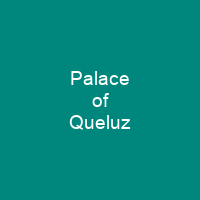Discover the Splendor of Portugal’s Palace of Queluz
Imagine stepping into a world where history and opulence intertwine, where every corner whispers tales of royal grandeur and architectural marvels. The Palace of Queluz, a 18th-century masterpiece in Portugal, is more than just a building; it’s a portal to the past. Located in the quaint town of Queluz, this palace has seen its fair share of royalty, tragedy, and transformation over the centuries.
The Birth of an Extravagance
Work on the Palace of Queluz began in 1747 under architect Mateus Vicente de Oliveira. The site was originally owned by Manuel de Moura y Corte Real before it was seized by the Portuguese Crown after the Spanish were driven from Portugal in 1640. This grand project was commissioned as a summer retreat for King Joseph I’s brother, Peter of Braganza, and later served as a place of refuge for Queen Maria I during her mental illness.
A Revolt Against Baroque
The palace’s design is a bold departure from the heavy Baroque architecture that dominated earlier periods. It reflects the lighter, more refined tastes of the Portuguese royal family at the time. The ‘Ceremonial Façade’ is a harmonious example of Portuguese Baroque architecture, featuring travertine rendering and delicately carved cartouches. This façade presents a severe and impassive public face, contrasting with the opulence within.
From Royal Retreat to State Guest House
After extensive restoration following a serious fire in 1934, Queluz became the official residence of the Portuguese Prince Regent John and his family. Today, one wing of the palace serves as Portugal’s official state guest house for visiting heads of state and government.
The Interior Splendor
Step inside and you’ll find yourself in a world of intricate detail and design. The Sala das Mangas is lined with tiled wall panels, while the Music Room features gilded and painted wood and an intricate ribbed ceiling. The Ball Room, designed by Robillon in 1760, boasts heavy gilding on its walls and ceiling, mirrored walls and doors, creating a dazzling spectacle of light and reflection.
The Chapel’s Sacred Space
The chapel beneath the large onion dome is dark and decorated in carved giltwood with intricate details highlighted in red, green, blue, and pink. The upper level has galleries for royal use and contains a small Rococo pipe organ. A feature of the chapel is an ornate, portable font with a marble basin resting in an elaborate frame.
The Gardens: A Symphony of Nature
But Queluz isn’t just about its grand interiors; it’s also renowned for its gardens. The topiary parterre, canals, statuary, fountains, and the grotto with a cascade create a living tapestry that enchants visitors. The garden temple Portico dos Cavalinhos features allegorical equestrian statues and sphinxes, adding to the palace’s rich narrative.
A Palace of Many Faces
From its humble beginnings as a summer retreat for Peter of Braganza to its current role as a state guest house, Queluz has seen many transformations. The palace’s history is a testament to Portugal’s rich cultural heritage and the enduring legacy of its royal family.
The Future of Queluz
Today, the Palace of Queluz stands as a museum open to the public since 1940. It houses much of the former royal collection and continues to captivate visitors with its beauty and history. The Queen Maria I Pavilion was renovated in 1957 to serve this purpose.
As you explore Queluz, ask yourself: What stories would these walls tell if they could speak? How do the rooms and gardens reflect the changing fortunes of Portugal’s royal family?

Queluz is more than just a palace; it’s a living museum, a testament to Portugal’s rich history and the enduring spirit of its royal family. As you wander through its halls and gardens, let your imagination run wild, conjuring up the tales that have been whispered here for centuries.
You want to know more about Palace of Queluz?
This page is based on the article Palace of Queluz published in Wikipedia (retrieved on November 29, 2024) and was automatically summarized using artificial intelligence.







